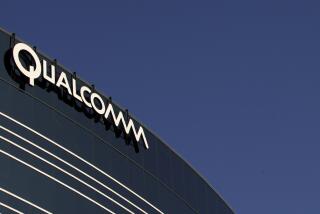Firm’s Technology May Be Digital Wave of the Future : Telecom: Qualcomm’s method of sending radio signals would expand cellular capacity and help cut down on fraud.
- Share via
SAN DIEGO — The defense industry is disappearing and the local economy is in the doldrums, but a young company called Qualcomm, founded by a pair of former computer science professors, is inspiring hope that this city will be lifted by high tech.
Qualcomm Inc.’s technology is certainly arcane: Going by the name of Code Division Multiple Access, or CDMA, it’s essentially a complicated way of sending digital radio signals over the airwaves. But with wireless communications expected to be one of the great growth industries of the coming decade, the company could be poised to hit it big.
Bringing a complex technology like CDMA to market is no picnic, and Qualcomm has had its share of setbacks in recent years. But the company got a huge boost late last month when Sprint Telecommunications Venture, an alliance of Sprint Corp., Tele-Communications Inc., Cox Communications and Comcast Corp., announced that it will use Qualcomm’s technology in an ambitious nationwide system to combine local and long-distance telephone service with new wireless offerings known as personal communications services, or PCS.
That victory came on top of the decision in June by PCS PrimeCo, a joint venture of Nynex, Bell Atlantic, US West and AirTouch Communications, to use CDMA as the basis for its nationwide network of next-generation wireless services.
“The war is far from over, but Qualcomm has established a very sound beachhead,” said Matthew Robison, senior analyst with Montgomery Securities in San Francisco. “The company has done an excellent job in bringing a very complex technology to a level of fruition sufficient to be endorsed by the carriers.”
Others on Wall Street are similarly optimistic. Qualcomm stock closed Tuesday at $41.875, off 87.5 cents for the day but double its 1995 low of $20.50, and the company has filed to raise $320 million in a secondary public offering.
The enthusiasm is based on the hope that Qualcomm’s technology can dramatically increase the capacity of cellular telephone networks and other wireless communications systems, while also making it more difficult to “clone” wireless phones and steal calls.
Today’s cellular systems use analog technology, in which the sound of a voice is represented by an undulating electrical wave. But cellular carriers are moving to high-capacity digital systems, in which sounds are converted to the ones and zeros of computer code--and the new PCS will also use digital technology.
The conventional method of implementing digital involves something called Time Division Multiple Access, in which the bit streams from different simultaneous calls share the same piece of a radio wave: A burst of one call is followed in an instant by the burst from another, and each is reassembled at the other end so quickly that no one hears the difference.
With CDMA, however, the different pieces of a single phone call are sent simultaneously over many different parts of the radio spectrum with a numerical code attached: The code then tells all but the targeted receiving device to ignore that signal.
It’s as if a room full of people were all speaking at once but in different languages: You could still pick out the language you wanted to hear.
Qualcomm’s technology is an outgrowth of the digital coding techniques developed by its founders, Irwin Jacobs and Andrew Viterbi, for military satellites in the late 1960s. Both were then part-time defense consultants holding down full-time jobs as computer science professors, Jacobs at UC San Diego and Viterbi at UCLA.
The duo subsequently left academe to found a San Diego company called Linkabit that invented the cable TV satellite scrambling methods that have become the standard.
Jacobs and Viterbi sold Linkabit to M/A-Com in 1980 and its video scrambling technology has since become the property of General Instrument Corp. of Chicago.
In 1985, Jacobs and Viterbi and four other employees formed Qualcomm with no specific product in mind. But by 1988 the company had developed a CDMA-based product called OmniTracs, a positioning and communications system for ships and trucks.
CDMA takes the company’s digital coding many steps further, greatly increasing cellular capacity and thwarting phone service thieves. Qualcomm plans to license the technology to all comers but also plans to make the hardware itself. Last year, it formed a joint venture with Sony to manufacture telephones at a plant in Rancho Bernardo, a San Diego suburb, across the street from Sony’s color television factory.
Qualcomm still faces plenty of obstacles. Competitors, including Northern Telecom and Motorola, are strong, and CDMA has yet to be proven in the field.
But no matter what happens later, for the time being business is booming. Sales have grown an average 50% annually over the past three years. Payroll now stands at 2,800 employees, up by 1,000 from a year ago. New hires include many laid-off engineers and technicians from General Dynamics and Hughes Aircraft.






